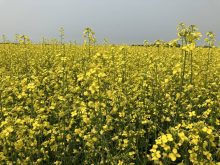The Western Producer’s Sean Pratt is reporting from the 2016 Global Pulse Convention in Cesme, Turkey.
There were more market outlook presentations during final day of the 2016 Global Pulse Convention.
G. Chandrashekhar, a global agribusiness and commodity sector specialist from India, provided his thoughts on the desi chickpea market.
He is forecasting 9.28 million tonnes of world production in 2016, up from 8.74 million tonnes last year. He believes 2017 production will approach 10 million tonnes.
The Indian government is targeting 9.5 million tonnes of total chickpea production for the crop that will be planted this fall and harvested in early 2017.

Chandrashekhar said that is highly unlikely. He believes there is an outside chance farmers will produce 8.5 million tonnes, 7.5 million tonnes of which would be desis.
He doesn’t believe the increase in production will weigh down prices. Last year there was 700,000 tonnes of opening stocks. In 2016-17 there will be nothing. The world will be completely reliant on new crop production.
Chandrashekhar believes the demand and supply situation will be tight.
“If anything prices are going up,” he said.
“Part of the tightness will be relieved by imports of yellow peas.”
Peter Wilson, chief executive officer of AGT Foods Australia, said Australia needs rain to arrive in the next couple of weeks in Queensland and New South Wales where the chickpeas are grown.
Read Also

New coal mine proposal met with old concerns
A smaller version of the previously rejected Grassy Mountain coal mine project in Crowsnest Pass is back on the table, and the Livingstone Landowners Group continues to voice concerns about the environmental risks.
If the rain comes there is potential to produce 1.6 million tonnes of desi chickpeas, up from last year’s 1.15 million tonnes. If it does not happen the crop could be closer to 700,000 tonnes.
Pakistan harvested a disappointing crop of about 325,000 tonnes, which is well below the record one million tonnes produced two years ago. It will need to import product from Australia.
Myanmar will be importing desi chickpeas for the first time ever due to a poor crop in that country.
Sudhakar Tomar, managing director of Hakan Agro, a Dubai based pulse trading company, is forecasting a two million tonne increase in world pea production in 2016-17.
But again, he doesn’t believe that will be burdensome due to pent up demand in India and China.
Australia’s crop is off to a terrific start. Nick Poutney, senior trader with GrainCorp, is forecasting 375,000 tonnes of production, up from a disappointing 200,000 tonnes last year.
Ozan Ozturk, managing director of Agrozan Commodities, estimates Russia will harvest 1.75 million tonnes of peas, Ukraine 600,000 tonnes and other countries in the Black Sea region another 650,000 tonnes.
Mike Allaire, senior commodity trader with Ilta Grain, is forecasting four million tonnes of Canadian production.
Panelists were split on whether they were bearish or bullish on peas. Some believe the increased production will weigh down prices, while others think pent-up demand will be strong enough to maintain or even exceed today’s prices.
sean.pratt@producer.com
Australia's desi chickpea crop will be made or lost in the next two weeks. If rain comes – 1.6 MT. If it doesn't – 700,000 MT. #westcdnag
— Sean Pratt (@sean_pratt) May 22, 2016
Pakistan harvesting 325,000 tonnes of desi chickpeas, which is less than half of the typical production. #westcdnag
— Sean Pratt (@sean_pratt) May 22, 2016

















